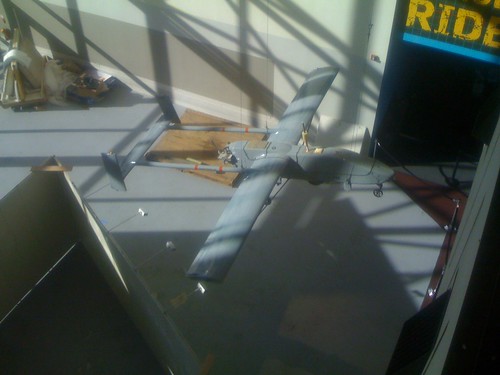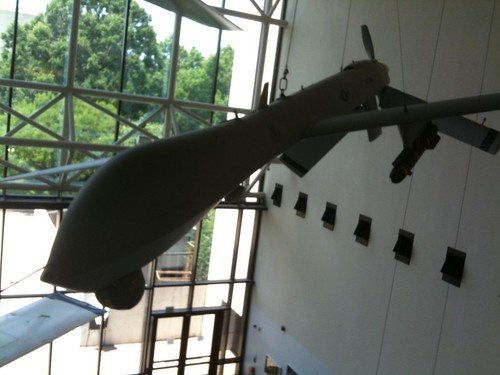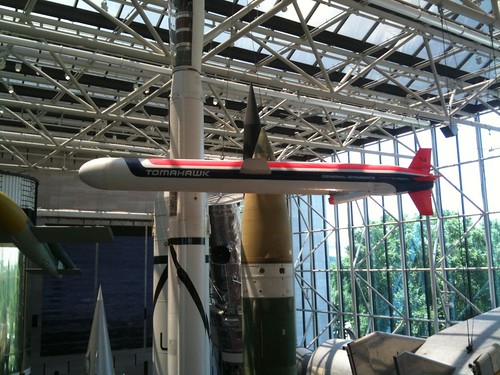The highlight of my visit to the Smithsonian Air and Space Museum at the end of June this summer, when I was in Washington DC for NECC 2009, was definitely seeing the completed UAV (Unmanned Aerial Vehicle) exhibit. My son, Alexander, helped me film and upload (from the Smithsonian, on-site) a five minute video from the UAV exhibit using my iPhone GS and its direct upload-to-YouTube feature over the AT&T 3G cell phone network.
In March 2008, Alexander and I were in Washington DC for the COsN Conference and saw the UAV exhibit taking shape, before its completion and official opening to the public.
At that time we used a Macbook laptop, DV camcorder, firewire cable, and AT&T broadband card to share and archive a live webcast from the Smithsonian Air and Space Museum as well as two webcasts from the Steven F. Udvar-Hazy Center near Washington Dulles International Airport via Ustream.tv. If you look at the quality of both audio and video in all three of those Ustream broadcasts, you’ll definitely appreciate the higher quality of the asynchronously shared (not webcasted) video from the iPhone GS.
Today’s CNN article, “How robot drones revolutionized the face of warfare,” got me thinking about the impact these aircraft have had and continue to have in ongoing U.S. military intervention activities in Iraq, Afghanistan, Pakistan, and elsewhere throughout the world. According to the article, quoting a UAV predator pilot:
Andrews fights not from the seat of the F16 he joined the air force to fly but from a darkened ground control station. He pilots a remote-controlled Predator, a UAV (unmanned aerial vehicle) which can spy on and attack positions and personnel without risk to its controller, shooting deadly Hellfire missiles at enemy fighters in support of fellow soldiers. “You’re talking to them on the radios as if we were in a normal airplane flying overhead,” says Andrews. “You see the imagery, you know what’s going on, you see what you’re looking at. It’s very easy when something like that is happening to project yourself there and feel a part of the battle. Like I said, your heart starts racing a little bit.”
This next statistic from the article really got my attention:
There are now more than 7,000 UAVs ranging from the workhorse, the Predator, and its beefier, deadlier kin the Reaper, to army drones like the tiny hand-launched Raven and the larger Shadow.
7000 UAVs?! Wow. I had no idea our unmanned aerial arsenal was that extensive.
Some U.S. military leaders are hailing the UAVs as the end to manned fighter aircraft for the USAF. Again quoting the CNN article:
Now U.S. Secretary of Defense Robert Gates wants more UAVs. Already he has said that the next generation of fighter planes — the F-35 that took decades to develop at a cost of more than half-a-billion dollars each — will be the last manned fighter aircraft.
Lt. Gen. David Deptula, USAF, explains that the next phase will enable a single drone to provide as many as 60 simultaneous live video feeds direct to combat troops. Some new drones will be as small as flies, others walk — all appear destined to work with decreasing human input.
“The future of how you use these un-manned systems or remotely piloted systems is really unlimited,” says Deptula, based at the Pentagon and racing to keep pace with battlefield needs as well as Gates’s demands. “We need to open our minds and think more about capability and impact we are going to achieve as opposed to how we’ve done business in the past.
The MSNBC article from today, “Bin Laden son thought killed in Pakistan,” reveals the number of US launched UAV attacks in Pakistani airspace to be around 45, since August 2008:
Saad bin Laden, a son of al-Qaida leader Osama bin Laden, may have been killed in a U.S. airstrike, U.S. officials said Thursday. The son was likely killed in Pakistan in the last several months, approximately in late spring, said a counterterrorism official, one of three Obama administration officials who spoke on condition of anonymity… The U.S. has carried out more than 45 missile attacks with drones in Pakistan’s border region since last August, most targeting foreign al-Qaida militants and those accused of violence in neighboring Afghanistan.
Interestingly, today’s CNN article just “hints” about these UAV attacks in Pakistan on suspected al-Qaida targets:
“The barriers of war in our society are already lowering,” he [Robotic warfare expert Peter Singer] says. “This tech may allow them to lower to the ground. And we might already be seeing this in the strikes being carried out on Pakistan.” He points out that raw numbers over the last year show the same number of strikes as the opening of the Kosovo war. “But we didn’t debate about it in Congress, we don’t talk about it daily in our media.”
Apparently Peter’s “might” should be changed to “are.” We SHOULD be talking about this a LOT more in our country.
What are the implications for today’s video game generation students? Again quoting the CNN article:
At Creech [Nevada] the demand for Predator pilots is so intense that it is mobilizing Air National Guard and reservists. It has also introduced an experimental training program for air force cadets from the videogame generation. Colonel Chris Chambliss, based at Creech, explains: “If you look at younger people right now, they multitask much better than I do. They can do a lot of things with a lot of different information, gather all that in. That’s certainly a skill set we need.” Cadet Greg Groves, who is in the Reserve Officers’ Training Corps, has never flown a plane before — but is well aware of his responsibilities. He says: “It’s pretty clear that it’s not a video game, and it is real life and that what I do directly affects someone else halfway around the world. So I don’t think that’s going to be a big problem for me.”
Cruise missile technologies have been employed even more extensively (from what I understand of military history) than UAVs, and were extensively utilized in the 1990-1991 Persian Gulf War.
The fact that a more responsive, actual pilot is at the controls of a UAV instead of a computer guidance system (in the case of a cruise missile) makes a big difference. It is remarkable to catch a glimpse of how these advanced technologies are impacting both military operations as well as military service in the Air Force. This sentence from the CNN article really got my attention:
Groves’ father and grandfather were both in the military: when he leaves for Creech he’ll be the first in his family to go to war without fear of dying.
I wonder if pilots in bygone days would have ever imagined aerial combat, ground attack, and close air support would evolve to this? Creech Air Force Base is located thousands of miles from Pakistan, Iraq, and Afghanistan.
Gene Stoltzfus’ April 2008 post, “Magic Bullets: From Agent Orange To Digital Warfare,” highlights important issues that should be at the forefront of not only policymakers’ minds who are employing UAVs in current combat operations, but also in our minds as voters and civic leaders in our communities, states and nation:
Two weeks ago during Holy Week as I watched Predators and Reapers at Creech AFB in Nevada practice touch down and take off, my mind stretched back 40 years to my own days as a civilian volunteer in Viet Nam when for a time I was in denial. I refused to believe that the US would spray chemicals from the air to destroy crops, vegetation and people. I was wrong then and could kick myself for being such a slow learner. I missed it because I thought war strategists would have more concern for civilian victims. The movement of digitally guided, unmanned systems on the ground, at sea, in the air and space are here for the duration. The technology, like the chemistry of Agent Orange is widely available and components can now or soon will be cobbled together from off the shelf. The players and advocates at the center of the movement are not yet sure of where it is going but I do know that split second decision making, often by young soldiers or civilians, will determine life and death for people. In each major transformation, nuclear bombs, chemical weapons, gunpowder, bows and arrows and others, new development has made war faster, and more deadly than the previous stage of military evolution. The digital age will further enlarge the distance between combatants and victims. There will be human, environmental and probably security costs, now only imagined in science fiction, 40 years down the road.
What are the chances a student sitting your your class today, itching to return home to play Halo, will one day have his or her fingers on the triggers of real warbirds transporting an arsenal of potential aerial death beyond the wildest imaginations of soldiers and generals living in every previous era of human history?
Probably better than you think.
Consider this final quotation from the CNN article:
Some commanders, such as Colonel Baxter Swift, based at USAF Balad in Iraq, says the future has only just begun. He says: “It’s almost like what the hot air balloon was back in the Civil War for us. ‘Hey, I can rise above and look around and see what the forces are doing on the battlefield.’ So now we are just in the pioneering stage.”
Our need for informed, moral leaders is as great as ever. Will the pureblood politicians please step aside, so the leaders, citizen-statesmen and women, and moral agents can take the podium? Our fingers are now on triggers far more powerful than our forefathers ever imagined we’d possess.
Technorati Tags:
airforce, iphone, iphonegs, military, smithsonian, uav, usaf, ustream, webcast, youtube, pilot, iraq, afghanistan, pakistan
If you enjoyed this post and found it useful, subscribe to Wes’ free newsletter. Check out Wes’ video tutorial library, “Playing with Media.” Information about more ways to learn with Dr. Wesley Fryer are available on wesfryer.com/after.
On this day..
- Media Literacy Conversations About Conspiracies and Culture Wars – 2020
- Explaining Telecommunications Convergence and Its Opportunities via Video – 2011
- Good Reasons to Try Google+ – 2011
- Lincoln in Kansas – Ideas for a collaborative Kansas student podcasting project – 2009
- What’s your media platform for knowledge sharing? – 2009
- Advice for web 1.0 to 2.0 (WordPress) page conversion? – 2007
- Rising treehouse expectations – 2007
- Notes on storytelling and improv, great 1st day as an ADE – 2005






Comments
One response to “Video game skills are serious business for the USAF: Meet the fleet of 7000 UAVs”
Cool exhibit! Thanks for sharing the pictures and video.
It is interesting that there are many job openings for UAV operators, at the moment, while at the same time the UAVs are becoming smarter and requiring less operator intervention. As technology advances it will become easier to control multiple UAVs from one ground station operated by a single operator.